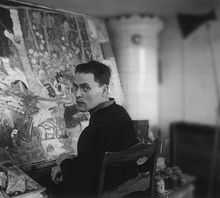Öyvind Fahlström
| Öyvind Fahlström | |
|---|---|
 Öyvind Fahlström. | |
| Born |
1928 Sao Paulo, Brazil |
| Died | 1976 |
| Nationality | Swedish |
| Movement | Fluxus |
Öyvind Axel Christian Fahlström (1928–1976) was a Swedish Multimedia artist.
Biography
Fahlström was born in Sao Paulo, Brazil, as the only child to Frithjof Fahlström and Karin Fahlström. In July 1939 he was sent to Stockholm to visit some distant relatives and after World War II he started to study and later on to work as a writer, critic and journalist. From 1960 until 1976 he was married to the Swedish Pop painter Barbro Östlihn.
Career
In 1953 Fahlström had his first solo exhibition, showing the drawing Opera, a room-sized felt-pen drawing. Also in 1953 he wrote Hätila ragulpr på fåtskliaben, a manifesto for concrete poetry, published in Swedish the following year and in English translation (by Mary Ellen Solt, in her anthology "Concrete Poetry. A world view") in 1968.
In 1956 Fahlström moved to Paris and lived there for three years before he moved to Front Street studio, New York City. In New York he worked with different artists and explored his role as an artist further. In 1962 he participated in the New Realists exhibition at the Sidney Janis Gallery, in New York City. His work was included in the 1964 Venice Biennale and he had a solo exhibition at Cordier & Ekstrom Inc., New York. In 1965 he joined the Sidney Janis Gallery.
In 1966 his work Performance of Kisses Sweeter Than Wine was included in 9 Evenings: Theatre and Engineering, organized by Experiments in Art and Technology at the 26th Street Armory, New York. The same year his painting in oil on photo paper was included in a group exhibition called Erotic Art at the Sidney Janis Gallery. Fahlström had solo exhibitions at the Sidney Janis Gallery in New York City in 1967, 1969, 1973 and 1976. In 1973 he wrote a play called The Black Room, based on the Watergate scandal, and he had a retrospective at Moore College of Art Gallery, in Philadelphia, Pa.
Fahlström's work is in the collection of the Museum of Modern Art[1]
Although some critics such as Frances Richard dismissed him as a "throwback to Surrealism or Agitprop at worst"[2] other critics, such as Mary Flanagan have seen his use of games as constituting examples of critical play.[3]
Death
He became a productive and well known artist that worked in many genres and often with political and social questions. On Swedish television he made a name for himself after he smoked a pipe that he claimed was hashish on a national broadcast.
In 1976 he died of cancer at the age of 48.
Selected exhibitions
|
|
|
|
References
- ↑ "MoMA - The Collection - Öyvind Fahlström (Swedish, born Brazil. 1928;1976)".
- ↑ Richard, Frances (May 2003), "Ovind Fahlstrom", Artforum 41 (9): 167–8
- ↑ Flanagan, Mary (2009), Critical Play
- Dr. Livingstone, I Presume av Öyvind Fahlström 1961
Kelley, Mike (2003). "Myth Science". In John C. Welchman. Foul Perfection : essays and criticism. Cambridge, MA: The MIT Press. pp. 158–177. ISBN 978-0-262-11270-3.
External links
|